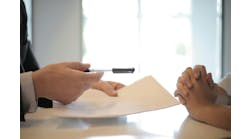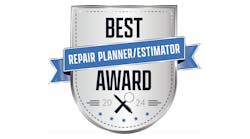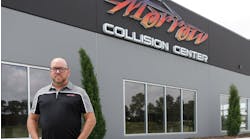As we continue with our third article in the series about advanced driver assistance systems (ADAS), we will be taking a closer look at radar. More specifically, the long-range radar typically used in most adaptive cruise control and collision braking systems.
Radar sensors are found in different areas of many modern vehicles. They can be located behind the rear bumper cover, behind the sides of the front bumper cover, or in the center of the front of the vehicle.
This last one is the one we are going to cover in this installment. As stated, it is typically mounted at or near the center of the vehicle, but not always. It can be located behind the front bumper cover or behind the grille. This radar sensor can be used for multiple ADAS but is almost always used with adaptive cruise control (ACC) and collision warning and braking systems. In addition, on some vehicles this radar is the only source of sensor input for these systems, while others also utilize a camera or even additional radar inputs.
Typically, a long-range radar sensor has the ability to detect objects several hundred feet in front of the vehicle. This long distance allows the ACC and other ADAS to detect vehicles far enough out to make any applicable adjustments or corrections in a controlled fashion. The radar sensor transmits a high-frequency radio signal that reflects off objects and returns to the sensor. The time it takes to receive a return signal is used to calculate the vehicle’s distance from an object.
When the radar becomes out of alignment due to various reasons, including a collision or a replacement of the radar, it will almost certainly need to be calibrated. Proper radar calibration is imperative to keep the detection area as it was intended and/or as it was from the factory.
Calibration is, in simple terms, the realigning of the radar orientation to where it is supposed to be. The idea is simple, but the process can be more complex. Factoring in that there are multiple ways that the radar can be calibrated, and that even within the same OEM, different vehicles may have different calibration procedures, understanding these differences and variables in how a radar is calibrated is essential. There are two main types of calibration, each with their own varied techniques depending upon the OEM and/or specific vehicle. These are static and dynamic calibrations.
Static calibration, as the name implies, is done with the vehicle stationary. Within a static calibration, the sensor may need to be accessed by removing the grille or bumper cover. This is because some procedures require the manual alignment of the radar by turning an adjusting screw and using a bubble level, angle gauge, or other similar device to measure if the radar is level or within specified degree of angle.
Other static calibration procedures will not require this manual adjustment and will be calibrated by using a scan tool and special tools such as a laser and reflectors. With the use of the scan tool, the radar is activated, and the reflection of the radar signal off of the precisely placed reflectors will determine and calibrate the correct sensing area of the radar.
Manual and electronic calibrations are not necessarily exclusive of one another. In some cases, an initial manual calibration is required, then the scan tool is used to “fine tune” the sensing area. In other instances, the manual alignment is used only to calibrate one axis of the sensor such as the vertical. Then the scan tool is used to calibrate the horizontal axis. Regardless of the method or combination of methods used to calibrate the radar sensor, using the correct tools, equipment, and procedure is vital to ensure that the calibration is performed accurately and correctly.
The required tool and equipment information for calibration is often found right in the calibration procedure. However, sometimes the tools needed may be listed elsewhere, such as in the radar replacement procedure or another specific area of the service or body repair manual (BRM). Often there are common items needed such as string, tape, and a marker. Although not special tools by any means, they are essential for the calibration process. Again, it is a good reminder that these tool requirements can change from vehicle to vehicle within an OEM and to always verify the tools needed for a specific vehicle.
Dynamic calibration is performed with the vehicle in motion. Again, the exact procedure will vary across OEMs and models. Regardless, the procedure will have specific parameters that the vehicle must be operated at. These may include driving at a specified speed, avoiding curved roads, following one or more vehicles, and may even require an environment with stationary objects on the side of the road. Following the parameters given will not only help ensure the calibration is performed correctly, it will likely reduce the time needed to successfully complete the calibration. Dynamic calibrations typically will require the use of a scan tool and may require two technicians; one to drive the vehicle and one to operate the scan tool. Even if the procedure does not specify, erroring on the side of safety by utilizing two technicians as needed is good practice.
Some dynamic calibrations will not require anything more than visually inspecting the radar bracket or mounting location for visible damage or deformation. Other procedures, like the static calibration mentioned above, will require the manual adjustment of the radar sensor prior to the dynamic calibration. Like the manual adjustment for static calibration, it will require the adjustment of at least one axis of the sensor and may require special tools.
One point to clarify is that a dynamic calibration is not the same as a test drive. If the vehicle requires a dynamic calibration, the test drive should not be done simultaneously. This is because the conditions for a test drive are not the same as the conditions in which a dynamic calibration is performed. A test drive should be performed after all static and dynamic calibrations are completed, often as a final step before the vehicle is delivered to the customer.
It is important to understand that a radar sensor that requires calibration will not necessarily trigger a warning light or error message. It is possible that a DTC can set for a calibration issue and the system will still function. The problem is, that the system likely is not functioning as it was designed to. This can cause false detection of obstacles, or worse yet, failure to identify an obstacle. This is why when working with radar, and ADAS in general, pre-and-post scanning of the vehicle is a must.
One additional point to mention in regard to replacing radar is that certain OEMs will require programming or coding when a radar sensor is replaced. Some OEMs require that the programming data needs to be downloaded from the old radar into the scan tool and then uploaded into the new radar. While other OEMs simply program or code the new radar directly from the scan tool.
When working with ADAS, it is vital to understand and follow vehicle specific procedures not only for programming and calibration details, but for special tools and equipment needed as well.
Note: for more information on I-CAR ADAS courses, news, webinars, podcasts and more, check out https://info.i-car.com/adas


